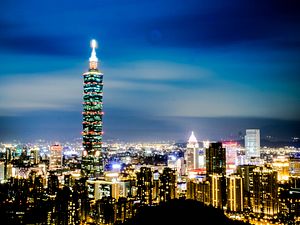Sitting in one of my Manhattan client’s office today, you cannot help but sometimes glance at the televisions. Since this is a financial institution, CNBC is naturally the station of choice. Normally the live shows discuss equities, options, or how the iPhone 7’s roll-out will impact Apple’s share price. The last several days also included discussions around the G20 summit hosted in Hangzhou, China, and its economic impact.
The commentary, however, is not what caught my attention, but rather a Chinese State Council Information Office (SCIO) commercial, developed by CNBC Catalyst. There is nothing unusual about the ad, until 56 seconds in. Suddenly, Taipei 101 makes an appearance, while the voiceover promotes the 13th Five Year Plan’s commitment to “maintain a medium-high rate of economic growth.”
Was including a Taiwanese landmark in a commercial showcasing China a simple editing mistake on CNBC’s part, or intentionally approved by the SCIO? Given the office’s history and target audiences, it is hard to believe Taipei 101’s appearance was not specifically by design, a subtle message to Taiwan’s new government, the United States, and the region, about the People’s Republic of China (PRC) view on the island.
SCIO hired CNBC’s advertising agency, CNBC Catalyst, to create the G20 advertisement as part of a promotional campaign for the Hangzhou meetings. The TV spot in question, entitled “G20, China Join In,” is currently running on CNBC’s global networks. While promoting PRC initiatives such as the Asia Infrastructure Investment Bank (AIIB) and the Belt and Road Initiative, the 1 minute and 30 second spot advocates for “joining in” on an “inclusive, interconnected, invigorated and innovative” economy as China hosts this year’s G20 summit. The narrator voices this message over a backdrop of beautiful scenes from across China — Hong Kong, Shanghai, Beijing and the countryside. To the untrained eye, nothing may seem out of the ordinary; however, one of the scenic views is a nighttime shot of Taipei 101, Taiwan’s tallest building. In fact, the skyscraper is synonymous with the island. To confirm that the building is indeed Taipei 101, the Shin Kong Life Tower is clearly visible in the video’s background, and the shot is similar to other pictures of Taipei’s skyline available online.
The question is whether there is any significance in this. Was it a simple mistake on the part of CNBC Catalyst? If one is not a China watcher or familiar with the region’s geopolitical situation, such a mistake is plausible. However, SCIO’s involvement makes it hard to believe this was a simple error. As part of the State Council, with a tight relationship to the Communist Party of China (CPC), the SCIO’s role is to promote Chinese policies and views, along with managing of what news is available on the Chinese internet. As early as 2010, SCIO identified the importance of external propaganda. The Wilson Center’s report on this office goes further, identifying Taiwanese as an important category of Overseas Chinese to be targeted by SCIO efforts, with the goal of isolating and opposing those who promote “Taiwanese independence” or are otherwise identified by the CPC as “anti-China.”
What editorial or approval authority the SCIO had with CNBC Catalyst is unknown, and potentially part of their statement of work. What is clear, however, is that Taipei 101 is prominently on display in an advertisement brought and paid for by the PRC’s propaganda arm. Does this have anything to do with return to power of the Democratic Progressive Party (DPP) in Taiwan, and President Tsai Ing-wen’s inaugural speech advocating for reducing dependence on the mainland? The PRC has not changed its position on Taiwan, and reaffirmed its opposition to any discussions on the matter.
Whether through statements from the state media, or more subtle indicators like the G20 commercial, the Communist Party is letting Taiwan, the DPP, the United States, and the region know that their views have not changed, and Beijing will oppose any move toward independence or greater autonomy. One China or not, as far as the mainland is concerned, Taipei 101 is part of the 13th Five Year Plan.
Justin D. Guiterman is a New York-based, Senior Manager financial consultant with Ernst & Young, LLP, working in the Financial Services Office Advisory practice. Justin is also a Lieutenant Commander in the United States Navy Reserve, previously serving in the Asia-Pacific region. The views expressed in this article do not reflect the opinions of Ernst & Young, LLP or the United States Navy.

































